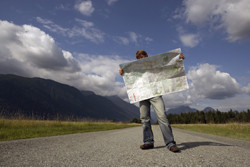Cues for navigation
Previous research has shown that slope may be a key spatial cue for reorientation. This may be because slope is not only seen but felt in the body through the angles of the joints and weight of the body, kinaesthesia. To test this theory, researchers in the project VERTICAL DIMENSION (The role of the vertical dimension in memory and navigation) developed a controlled laboratory environment with a simple vertical dimension — a tilted floor. The researchers generated a sloped, virtual environment. They presented 2D images on a computer monitor with an eye-tracking device. Participants viewed this image and were asked to point uphill as quickly as possible. The aim of the experiment was to test if visual cues were sufficient for accurate slope perception. Subjects accomplished this task accurately and quickly using only visual cues. This suggests that visual cues may be sufficient for slope processing and may be relied on just as much — if not more — than kinaesthesia. Interestingly, backing up other studies, women showed longer reaction time and more errors compared to men suggesting they have difficulty in the visual modality. However, despite this, there are no differences in the visual strategies and they rely on the same visual cues. If slope substantially improves navigation ability, the research may have important implications for geography and urban planning. To point travellers in the right direction, for example, signs may use uphill or downhill designations rather than turn left and right.



